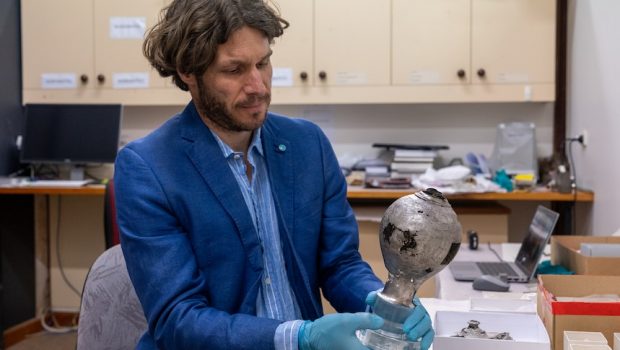3D imaging of Batavia shipwreck silverware uncovers new insights into 17th century shipping trade
Researchers and the public will soon be able to get a better view of priceless silverware recovered from the Batavia shipwreck in a collaboration between institutions in Western Australia and Amsterdam.
Key points:
- Unique silverware was recovered from the Batavia shipwreck in the 1970s
- New 3D imaging has been developed to help study the pieces
- Experts in WA and the Netherlands are collaborating on a research project
The ship carrying 341 people was wrecked at the Abrolhos Islands off WA's west coast in 1629 and a bloody mutiny followed.
Also on board were silver items created especially to export to India.
University of WA art historian and researcher Arvi Wattel said the designs on the silverware gave an insight into 17th-century trade when the Dutch were trying to cash in on the wealth of the Mughal Dynasty.
"The objects that we found were made for the emperor of India in a trial," he said.
"The Dutch East India Company tried to make a profit of course, and they were losing a lot of money on their trade with India, so they came up with this idea to make objects that the Indians could use in silver and help to make a lot of profit off that."
Mr Wattel said the items included a water jug with illustrations of the emperor.
The items had been collected and catalogued when the wreck was recovered five decades ago, he said.
"This material has been lying on a seabed for over 300 years and was recovered in the 1970s, but ever since, not much has been done with it," Mr Wattel said.
New technology 'disentangles' histories
Professor Robert Erdmann from Rijksmuseum in Amsterdam said studying the items had been difficult as the silver acted like a mirror, reflecting its environment.
He designed and built a specialised turntable integrated with a camera.
"It's able to have a resolution of one-millionth of a turn," he said.
"So they move, take a photo, move, take a photo and that enables us to take a huge number of photos in a full circle.
"We're taking about 3–4 terabytes of data for about 25 objects or so but in the end, the goal is to visualise the silverware and then also bring that, not just to researchers, but also to the public so they'll be able to interact with it and get a feel for how amazing and beautiful and rich these objects are."
Metals specialist Tamar Davidowitz from the University of Amsterdam said the project would help disentangle the different histories of the objects from the time of construction through to their centuries on the ocean floor.
"How they were made, what kind of decision-making was being done by the silversmith creating them, the moment the ship sunk and when they were excavated and cleaned, and then ultimately restored quite intensively," she said.
As well as being useful for researchers, the WA Shipwreck Museum is creating a new display so visitors can see the item in real life with the 3D creation on a touchscreen.









Gloss